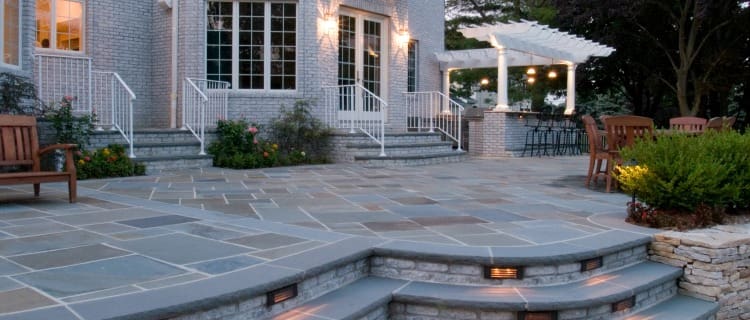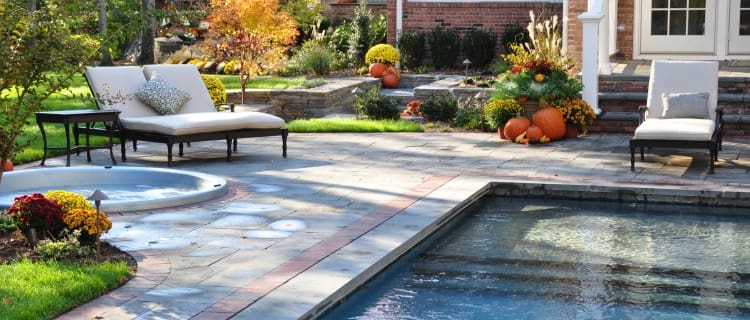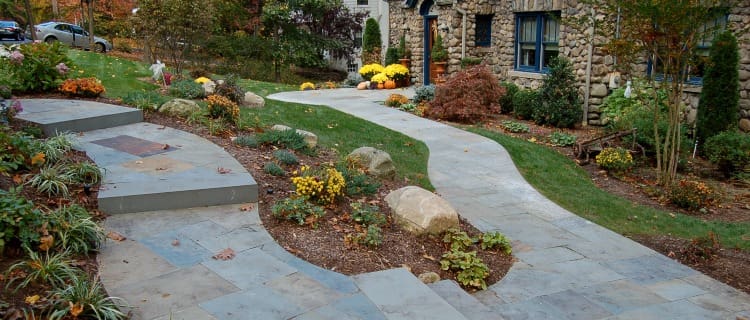If you’re looking for a patio flooring option that offers stunning beauty and long-term durability, take a closer look at outdoor slate tile. As a natural stone that’s filled with unique colors and textures, slate provides a sophisticated appearance with earthy appeal.
Slate is a beautiful stone that lends an organic look to any landscape. With a variety of types and colors to choose from, you can easily find an outdoor slate tile that complements the style of your Northern NJ home. Known for its natural beauty and unique appearance, slate offers many advantages for your backyard patio, so let us take a closer look at the beauty and versatility of outdoor slate tile.
 Natural Beauty
Natural Beauty
Slate is a natural stone formed from metamorphic rock deep beneath the ground. It’s formed from layers of shale subjected to intense heat and movement pressure. When the clay and fine particles of quartz, mica and other minerals found in the shale are subjected to high heat and movement pressure, they form a hard stone with intense color variations, interesting textures and unique design appeal.
The natural beauty of slate is created underground, so density, strength and color variations can vary greatly. Outdoor slate tile should be chosen carefully, since no two tiles are ever alike.
Like all natural stones mined from the earth, slate is dense and strong and holds up well in outdoor elements. It’s slightly softer than granite and marble, but provides a surface that’s non-porous and non-absorbent. Slate comes in a variety of colors that range from dark blacks and browns, to reds, rusts, purples, greens, blue-grays and tans.
Color variations from tile to tile create interesting visual appeal and unique contrast for any outdoor patio. The earthy, organic appearance of slate creates a natural stone that works with any style of architecture and blends in naturally to any landscape.
Vermont Slate
Vermont slate is usually smoother and denser than other types of slates. It tends to have less color variation, so it gives the appearance of one color. It’s strong and durable with a low-water absorption rate, an important factor when selecting outdoor tiles.
Brazilian Slate
Brazilian slate is available in many interesting color variations and textures. Colors tend to be more intense and often vary greatly in one single piece. It’s hard, dense and non-porous with a low-water absorption rate.
Chinese and Indian Slates
Slates mined in these areas have wonderful color variations, but tend to be softer and more porous. Softer slates are prone to more cracking and chipping and will absorb more water. They are better for indoor use or covered, indoor patio areas.
Quarries in Wales, Portugal, Brazil, the United Kingdom, New York and Vermont are known for high- quality, dense slate. Outdoor slate tile that’s quarried in these areas will last a lifetime on your outdoor patio with proper care and maintenance.
 Choosing Slate Flooring Tiles
Choosing Slate Flooring Tiles
When choosing slate flooring tiles for your patio, it’s important to consider the size, shape and color of the tiles. Since slate has a lot of color variation, it’s best to ask for sample pieces from the actual batch of slate that you will be purchasing from.
Don’t make a selection based on a showroom sample that’s on display. The display sample may have been sitting on the shelf for months and look nothing like the actual slate tiles you are buying.
When selecting your actual tiles, inspect the sides of the stone looking for cracks, voids or loose layers. If the slate shows these conditions, it may have trouble maintaining its integrity outdoors over the years. Ideally, choose a slate that is relatively non-directional in the way that it breaks. Slate that breaks in lines rather than chunks may be best suited for indoor use rather than outdoor use.
Outdoor slate tile has beautiful depth and texture, and each individual tile has unique life and character. Uneven surface textures give slate bumps and ridges that provide excellent slip-resistance when used outdoors.
The texture of slate also changes the way it appears throughout the day in different light situations. To get an accurate idea of color, you may want to lay a few sample tiles outdoors to see what happens to the color during the day before you make your final purchase.
Whether you have a wonderful, old traditional home or a sleek, new modern one, a slate tile patio will enhance the beauty and style. Choose a color that enhances existing materials and colors on your home.
For natural, subtle appeal, select a slate color that blends in naturally to your home and outdoor surroundings. If you want to create contrast, select a color that stands out, but still complements your home and landscape.
Care and Maintenance Tips
Although outdoor slate tile is strong and durable, all natural stones require appropriate cleaning and regular sealing when used outdoors. Otherwise, they are subject to all types of stains from outdoor debris, as well as foods and drinks spilled while entertaining.
To keep your slate patio looking its best year-round, follow these care and maintenance tips:
- Apply a water-barrier sealer to the slate after installation. Choose a sealer based on your slate. Some sealers are better for more porous stones, while others work best for low-water absorption stones.
- Apply a non-yellowing protective finish to the slate every few months to prevent fading and weathering.
- If spills occur, clean them up as quickly as possible.
- When cleaning your slate tiles, don’t use cleaners that contain acid, or abrasive cleaners that will scratch the slate. For best results, combine 1/4 cup of mild detergent or a slate floor cleaner with two gallons of warm water. Mope the slate, then allow it to dry completely
 Installation Tips
Installation Tips
When installing your outdoor slate tile, it’s best to hire a professional landscape contractor, like Borst Landscape & Design, for best long-term results. A professional can ensure proper installation that will prevent cracking, chipping and damage as natural ground settling occurs over time.
A good contractor will lay out the slate exactly as it will look on your project, then make any necessary cuts to achieve proper placement and slope. Getting the right slope ensures proper drainage to discourage standing water that can impact the strength of the slate.
Typically, slate tiles are installed over a concrete slab to cut down on potential cracks and chips. If tiles are installed over a soft or porous surface, they will be prone to cracking and dampness which can cause tiles to disintegrate over time. Your contractor will make sure that the slate has full coverage with thin-set on the back and a crack isolation membrane to keep cracks in the concrete slab from transferring to your slate.
During installation, make sure that tiles are installed evenly to avoid trip hazards at the joints. Installing or floating the tiles in mortar will help to prevent this problem. If you prefer a shiny look instead of a rough finish, that can be achieved with the right sealants.
Wet sealers are best for slate that’s installed in an area where grease and oils are prevalent, or another area where there’s a possibility of heavy stains. A regular sealer with a non-glossy finish will protect against stains and spills, but let the natural beauty of the slate come through.
When installing an outdoor slate tile patio for your Bergen County home, talk to your contractor about protection during cold winter months. During Northern NJ winters with snow, ice and freezing rain, a freeze-thaw cycle can cause the water to expand in your stone and crack the slate. This is one more important reason for using a protective sealer on a regular basis.
If it’s time for a new patio, or you just want to update the look of your old one, talk to the landscape professionals at Borst about a beautiful outdoor slate tile patio. We can help you design and install a patio that will increase your outdoor enjoyment and enhance the beauty of your home.

 Natural Beauty
Natural Beauty Choosing Slate Flooring Tiles
Choosing Slate Flooring Tiles Installation Tips
Installation Tips